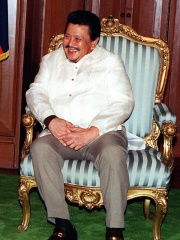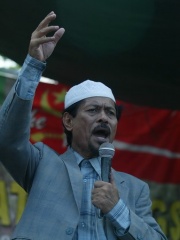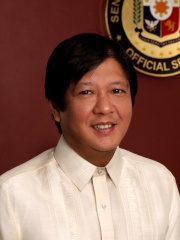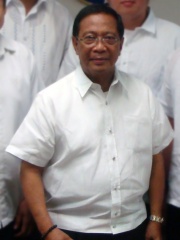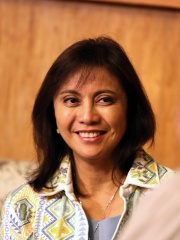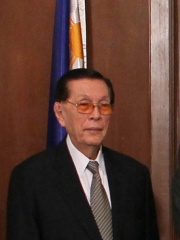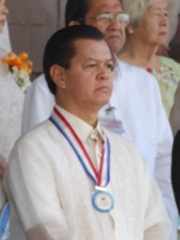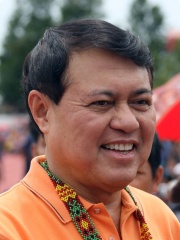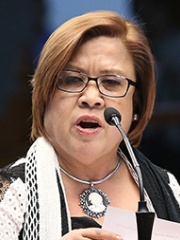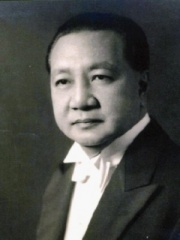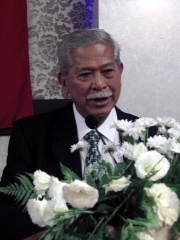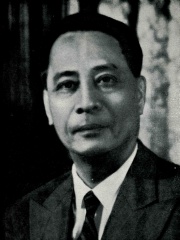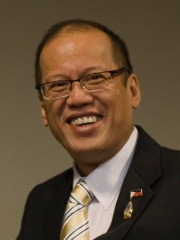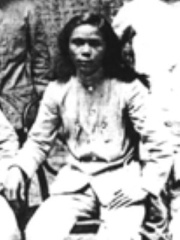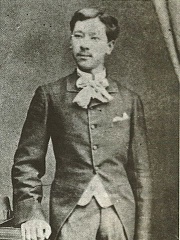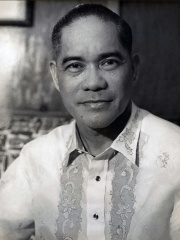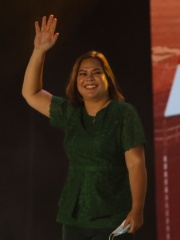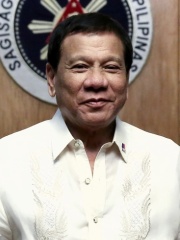
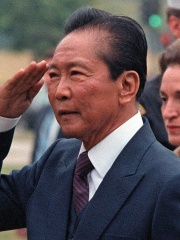
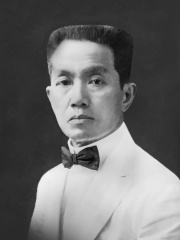
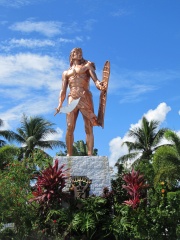
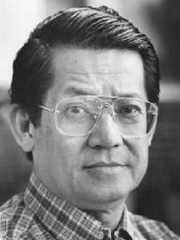
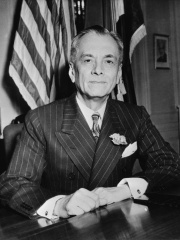
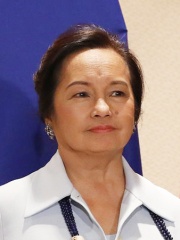
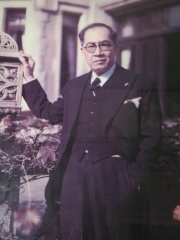
The Most Famous
POLITICIANS from Philippines
This page contains a list of the greatest Filipino Politicians. The pantheon dataset contains 15,577 Politicians, 45 of which were born in Philippines. This makes Philippines the birth place of the 65th most number of Politicians behind Venezuela and Lebanon.
Top 10
The following people are considered by Pantheon to be the top 10 most legendary Filipino Politicians of all time. This list of famous Filipino Politicians is sorted by HPI (Historical Popularity Index), a metric that aggregates information on a biography’s online popularity. Visit the rankings page to view the entire list of Filipino Politicians.

1. Rodrigo Duterte (1945 - )
With an HPI of 78.54, Rodrigo Duterte is the most famous Filipino Politician. His biography has been translated into 89 different languages on wikipedia.
Rodrigo Roa Duterte (English: , Tagalog: [ɾɔˈdɾigɔ ˈɾɔwa dʊˈtɛɾtɛ] ; born March 28, 1945), also known as Digong, Rody, and by the initials DU30 and PRRD, is a Filipino lawyer and politician who served as the 16th president of the Philippines from 2016 to 2022. He is the chairperson of Partido Demokratiko Pilipino (formerly PDP–Laban), the ruling political party in the Philippines during his presidency. Duterte is the first president of the Philippines to be from Mindanao, and is the oldest person to assume office, beginning his term at age 71. Born in Maasin, Leyte (now in Southern Leyte), Duterte moved to Davao as a child where his father, Vicente Duterte, served as provincial governor. He studied political science at the Lyceum of the Philippines University, graduating in 1968, before obtaining a law degree from San Beda College of Law in 1972. He then worked as a lawyer and was a prosecutor for Davao City, before becoming vice mayor and, subsequently, mayor of the city in the wake of the 1986 People Power Revolution. Duterte won seven terms and served as mayor of Davao for over 22 years, during which the once crime-ridden city became peaceful and investor-friendly. Duterte's 2016 presidential campaign led to his election victory. During his presidency, his domestic policy focused on combating the illegal drug trade by initiating the controversial war on drugs, fighting crime and corruption, and intensified efforts against terrorism and communist insurgency. He launched a massive infrastructure plan, initiated liberal economic reforms, streamlined government processes, and proposed a shift to a federal system of government which was ultimately unsuccessful. He also oversaw the controversial burial of Ferdinand Marcos, the 2017 Battle of Marawi, and the government's response to the COVID-19 pandemic. He declared the intention to pursue an "independent foreign policy", and strengthened relations with China and Russia. He initially announced his candidacy for vice president in the 2022 election, but in October 2021, said he was retiring from politics. The next month, he filed his candidacy for senator but withdrew it on December 14. Duterte's political positions have been described as populist, as well as nationalist. His political success has been aided by his vocal support for the extrajudicial killing of drug users and other criminals. His career has sparked numerous protests and attracted controversy, particularly over human rights issues and his controversial comments. Duterte has repeatedly confirmed to have personally killed criminal suspects during his term as mayor of Davao. Extrajudicial killings that were allegedly committed by the Davao Death Squad between 1998 and 2016 during Duterte's mayoralty have also been scrutinized by human-rights groups and the Office of the Ombudsman. The victims were mainly alleged drug users, alleged petty criminals, and street children. The International Criminal Court opened a preliminary investigation into Duterte's drug war in 2018, prompting Duterte to withdraw the Philippines from the body in response. He is the only president in the history of the Philippines not to declare his assets and liabilities. Duterte's popularity and domestic approval rating remained relatively high throughout his presidency and by the end of his term, he was the most popular post-EDSA (1986 People Power Revolution) president.

2. Ferdinand Marcos (1917 - 1989)
With an HPI of 63.73, Ferdinand Marcos is the 2nd most famous Filipino Politician. His biography has been translated into 126 different languages.
Ferdinand Emmanuel Edralin Marcos Sr. (September 11, 1917 – September 28, 1989) was a Filipino politician, lawyer, dictator, and kleptocrat who served as the tenth president of the Philippines from 1965 to 1986. He ruled under martial law from 1972 until 1981 and kept most of his martial law powers until he was deposed in 1986, branding his rule as "constitutional authoritarianism": 414 under his Kilusang Bagong Lipunan (New Society Movement). One of the most controversial leaders of the 20th century, Marcos's rule was infamous for its corruption, extravagance, and brutality. Marcos gained political success by claiming to have been the "most decorated war hero in the Philippines", but many of his claims have been found to be false, with United States Army documents describing his wartime claims as "fraudulent" and "absurd". After World War II, he became a lawyer then served in the Philippine House of Representatives from 1949 to 1959 and the Philippine Senate from 1959 to 1965. He was elected president of the Philippines in 1965 and presided over an economy that grew during the beginning of his 20-year rule but would end in the loss of livelihood, extreme poverty for almost half the Philippine population, and a crushing debt crisis. He pursued an aggressive program of infrastructure development funded by foreign debt, making him popular during his first term, although it triggered an inflationary crisis which led to social unrest in his second term. Marcos placed the Philippines under martial law on September 23, 1972, shortly before the end of his second term. Martial law was ratified in 1973 through a fraudulent referendum. The constitution was revised, media outlets were silenced, and violence and oppression were used against the political opposition, Muslims, suspected communists, and ordinary citizens. After being elected for a third term in the 1981 presidential election and referendum, Marcos's popularity suffered greatly, due to the economic collapse that began in early 1983 and the public outrage over the assassination of opposition leader Senator Benigno "Ninoy" Aquino Jr. later that year. This discontent, the resulting resurgence of the opposition in the 1984 parliamentary election, and the discovery of documents exposing his financial accounts and false war records led Marcos to call the snap election of 1986. Allegations of mass cheating, political turmoil, and human rights abuses led to the People Power Revolution of February 1986, which removed him from power. To avoid what could have been a military confrontation in Manila between pro- and anti-Marcos troops, Marcos was advised by US president Ronald Reagan through Senator Paul Laxalt to "cut and cut cleanly". Marcos then fled with his family to Hawaii. He was succeeded as president by Aquino's widow, Corazon "Cory" Aquino. According to source documents provided by the Presidential Commission on Good Government (PCGG), the Marcos family stole US$5 billion–$10 billion from the Central Bank of the Philippines. The PCGG also maintained that the Marcos family enjoyed a decadent lifestyle, taking away billions of dollars from the Philippines between 1965 and 1986. His wife, Imelda Marcos, made infamous in her own right by the excesses that characterized her and her husband's "conjugal dictatorship", is the source of the term Imeldific. Two of their children, Imee and Bongbong, are active in Philippine politics, with Bongbong having been elected president in the 2022 presidential election. Ferdinand and Imelda Marcos held the Guinness World Record for the largest-ever theft from a government for decades, although Guinness took the record down from their website while it underwent periodic review a few weeks before the 2022 election.

3. Emilio Aguinaldo (1869 - 1964)
With an HPI of 62.40, Emilio Aguinaldo is the 3rd most famous Filipino Politician. His biography has been translated into 62 different languages.
Emilio Aguinaldo y Famy (Spanish: [eˈmiljo aɣiˈnaldoj ˈfami]: March 22, 1869 – February 6, 1964) was a Filipino revolutionary, statesman, and military leader who is the youngest president of the Philippines (1899–1901) and became the first president of the Philippines and of an Asian constitutional republic. He led the Philippine forces first against Spain in the Philippine Revolution (1896–1898), then in the Spanish–American War (1898), and finally against the United States during the Philippine–American War (1899–1901). Aguinaldo is known as a national hero in the Philippines. However, he is also somewhat controversial in the country due to his alleged involvement in the deaths of the revolutionary leader Andrés Bonifacio and general Antonio Luna, and for his collaboration with the Japanese Empire during their occupation of the Philippines in World War II.

4. Lapu-Lapu (1491 - 1542)
With an HPI of 62.30, Lapu-Lapu is the 4th most famous Filipino Politician. His biography has been translated into 43 different languages.
Lapulapu (fl. 1521) or Lapu-Lapu, whose name was first recorded as Çilapulapu, was a datu (chief) of Mactan, an island now part of the Philippines. Lapulapu is known for the 1521 Battle of Mactan, where he and his men defeated Spanish forces led by Portuguese explorer Ferdinand Magellan and his native allies Rajah Humabon and Datu Zula. Magellan's death in battle ended his voyage of circumnavigation and delayed the Spanish occupation of the islands by over forty years until the expedition of Miguel López de Legazpi in 1564. Modern Philippine society regards him as the first Filipino hero because of his resistance to Spanish colonization. Monuments of Lapulapu have been built all over the Philippines to honor Lapulapu's bravery against the Spaniards. The Philippine National Police and the Bureau of Fire Protection use his image as part of their official seals. Besides being a rival of Rajah Humabon of neighboring Cebu, very little is reliably known about the life of Lapulapu. The only existing primary source mentioning him by name is the account of Antonio Pigafetta, and according to historian Resil B. Mojares, no European who left a primary record of Magellan's voyage/vessel "knew what he looked like, heard him speak (his recorded words of defiance and pride are all indirect), or mentioned that he was present in the battle of Mactan that made him famous." His name, origins, religion, and fate are still a matter of controversy.
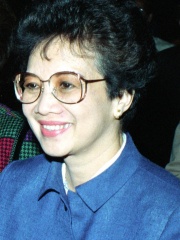
5. Corazon Aquino (1933 - 2009)
With an HPI of 61.84, Corazon Aquino is the 5th most famous Filipino Politician. Her biography has been translated into 95 different languages.
Maria Corazon "Cory" Sumulong Cojuangco-Aquino (Tagalog: [kɔɾaˈsɔn kɔˈhwaŋkɔ aˈkino]; January 25, 1933 – August 1, 2009) was a Filipino politician who served as the eleventh president of the Philippines from 1986 to 1992. She was the most prominent figure of the 1986 People Power Revolution, which ended the two-decade rule of President Ferdinand Marcos and led to the establishment of the current democratic Fifth Philippine Republic. Corazon Aquino was married to Senator Benigno Aquino Jr., who was one of the most prominent critics of President Marcos. After the assassination of her husband on August 21, 1983, she emerged as leader of the opposition against the president. In late 1985, Marcos called for a snap election, and Aquino ran for president with former Senator Salvador Laurel as her running mate for vice president. After the election held on February 7, 1986, the Batasang Pambansa proclaimed Marcos and his running mate Arturo Tolentino as the winners, which prompted allegations of electoral fraud and Aquino's call for massive civil disobedience actions. Subsequently, the People Power Revolution, a non-violent mass demonstration movement, took place from February 22 to 25. The People Power Revolution, along with defections from the Armed Forces of the Philippines and support from the Philippine Catholic Church, ousted Marcos and secured Aquino's accession to the presidency on February 25, 1986. Prior to her election as president, Aquino had not held any elected office. She was the first female president of the Philippines. As president, Aquino oversaw the drafting of the 1987 Constitution, which limited the powers of the presidency and re-established the bicameral Congress, removing the previous dictatorial government structure. Her economic policies focused on forging good economic standing amongst the international community as well as disestablishing Marcos-era crony capitalist monopolies, emphasizing the free market and responsible economy. Her administration pursued peace talks to resolve the Moro conflict, and the result of these talks was creation of the Autonomous Region in Muslim Mindanao. Aquino was criticized for the Mendiola Massacre, which resulted in the shooting deaths of at least 12 peaceful protesters by Philippine state security forces. The Philippines faced various natural calamities in the latter part of Aquino's administration, such as the 1990 Luzon earthquake, 1991 Mt. Pinatubo eruption and Tropical Storm Thelma. Several coup attempts were made against her government. She was succeeded as president by Fidel V. Ramos and returned to civilian life in 1992. Aquino was diagnosed with colorectal cancer in 2008 and died on August 1, 2009. Her son Benigno Aquino III served as president of the Philippines from 2010 to 2016. After her death, monuments were built and public landmarks were named in honor of Corazon Aquino all around the Philippines. Aquino was regarded as the Mother of Democracy.

6. Benigno Aquino Jr. (1932 - 1983)
With an HPI of 55.77, Benigno Aquino Jr. is the 6th most famous Filipino Politician. His biography has been translated into 45 different languages.
Benigno "Ninoy" Simeon Aquino Jr., (, locally [bɛˈniɡnɔʔ aˈkino]; November 27, 1932 – August 21, 1983) was a Filipino politician who served as a senator of the Philippines (1967–1972) and governor of the province of Tarlac. Aquino was the husband of Corazon Aquino, who became the 11th president of the Philippines after his assassination, and father of Benigno Aquino III, who became the 15th president of the Philippines. Aquino, together with Gerardo Roxas and Jovito Salonga, helped form the leadership of the opposition towards then President Ferdinand Marcos. He was the significant leader who together with the intellectual leader Sen. Jose W. Diokno led the overall opposition. Early in his Senate career, Aquino vigorously attempted to investigate the Jabidah massacre in March 1968. Shortly after the imposition of martial law in 1972, Aquino was arrested along with other members of the opposition. He was incarcerated for seven years. He has been described as Marcos' "most famous political prisoner". He founded his own party, Lakas ng Bayan and ran in the 1978 Philippine parliamentary election, but all the party's candidates lost in the election. In 1980, he was permitted by Marcos to travel to the United States for medical treatment following a heart attack. During the early 1980s he became one of the most notable critics of the Marcos regime, and enjoyed popularity across the US due to the numerous rallies he attended at the time. As the situation in the Philippines worsened, Aquino decided to return to face Marcos and restore democracy in the country, despite numerous threats against it. He was assassinated at Manila International Airport on August 21, 1983, upon returning from his self-imposed exile. His death revitalised opposition to Marcos; it also catapulted his widow, Corazon, into the political limelight and prompted her to successfully run for a six-year term as president as a member of the United Nationalist Democratic Organization (UNIDO) party in the 1986 snap election. Among other public structures, Manila International Airport has since been renamed Ninoy Aquino International Airport in his honor, and the anniversary of his death is a national holiday. Aquino has also been listed as a Motu Proprio human rights violations victim of the Martial Law era.

7. Manuel L. Quezon (1878 - 1944)
With an HPI of 55.67, Manuel L. Quezon is the 7th most famous Filipino Politician. His biography has been translated into 51 different languages.
Manuel Luis Quezon y Molina (UK: , US: , Tagalog: [maˈnwel ˈluwis ˈkɛson], Spanish: [maˈnwel ˈlwis ˈkeson i moˈlina]; 19 August 1878 – 1 August 1944), also known by his initials MLQ, was a Filipino lawyer, statesman, soldier, and politician who was president of the Commonwealth of the Philippines from 1935 until his death in 1944. He was the first Filipino to head a government of the entire Philippines and is considered the second president of the Philippines after Emilio Aguinaldo (1899–1901), whom Quezon defeated in the 1935 presidential election. During his presidency, Quezon tackled the problem of landless peasants. Other major decisions included the reorganization of the islands' military defense, approval of a recommendation for government reorganization, the promotion of settlement and development in Mindanao, dealing with the foreign stranglehold on Philippine trade and commerce, proposals for land reform, and opposing graft and corruption within the government. He established a government in exile in the U.S. with the outbreak of World War II and the threat of Japanese invasion. Scholars have described Quezon's leadership as a "de facto dictatorship" and described him as "the first Filipino politician to integrate all levels of politics into a synergy of power" after removing his term limits as president and turning the Senate into an extension of the executive through constitutional amendments. Quezon died of tuberculosis in Saranac Lake, New York, during his exile. He was buried at Arlington National Cemetery until the end of World War II, when his remains were moved to Manila. and interred at Manila North Cemetery in 1946. His remains were finally transferred to his final resting place in 1979 inside the Quezon Memorial Circle. In 2015, the Board of the International Raoul Wallenberg Foundation bestowed a posthumous Wallenberg Medal on Quezon and the people of the Philippines for reaching out to victims of the Holocaust from 1937 to 1941. President Benigno Aquino III and then-94-year-old Maria Zenaida Quezon Avanceña, the daughter of the former president, were informed of this recognition.

8. Gloria Macapagal Arroyo (1947 - )
With an HPI of 54.53, Gloria Macapagal Arroyo is the 8th most famous Filipino Politician. Her biography has been translated into 80 different languages.
Maria Gloria Macaraeg Macapagal-Arroyo (Tagalog: [ˈɡloɾja makapaˈɡal ʔaˈɾojo]; born April 5, 1947), often referred to by her initials PGMA and GMA, is a Filipino academic and politician who previously served as the 14th President of the Philippines from 2001 to 2010. She is the longest serving president of the Philippines since Ferdinand Marcos. Before her accession to the presidency, she served as the 10th Vice President of the Philippines from 1998 to 2001 under President Joseph Ejercito Estrada, making her the country's first female vice president, despite having run on an opposing ticket. She was also a Senator from 1992 to 1998. After her presidency, she was elected as the Representative of Pampanga's 2nd district in 2010 and later became the Speaker of the House of Representatives on 2018 to 2019. She was also serving in the congress as a Deputy Speaker from 2016 to 2017 and from 2022 until 2023. She is one of the only 2 Filipinos to hold at least three of the four highest offices in the country: vice president, president, and house speaker, alongside former President Sergio Osmeña. The daughter of former president Diosdado Macapagal, she studied economics at Georgetown University in the United States, where she began a lasting friendly relationship with her classmate and future U.S. president Bill Clinton. She then became a professor of economics at Ateneo de Manila University, where her eventual successor, President Benigno Aquino III, was one of her students. She entered government in 1987, serving as the assistant secretary and undersecretary of the Department of Trade and Industry upon the invitation of President Corazon Aquino, Benigno's mother. After Estrada was accused of corruption, Arroyo resigned her cabinet position as secretary of the Department of Social Welfare and Development and joined the growing opposition against the president, who faced impeachment. Estrada was soon forced out from office by the Second EDSA Revolution in 2001, and Arroyo was sworn into the presidency by Chief Justice Hilario Davide, Jr. on January 20 that year. In 2003, the Oakwood mutiny occurred after signs of a martial law declaration were seen under her rule. She was elected to a full six-year term in the controversial 2004 presidential election, and was sworn in on June 30, 2004. A long-time opponent of the death penalty, she abolished capital punishment in 2006 after commuting the death sentences of over 1,200 prisoners. Following her presidency, she was elected to the House of Representatives through her home district, making her the second Philippine president—after José P. Laurel—to pursue a lower office after their presidency. On November 18, 2011, Arroyo was arrested and held at the Veterans Memorial Medical Center in Quezon City under charges of electoral sabotage but released on bail in July 2012. These charges were later dropped for lack of evidence. She was rearrested in October 2012 on false charges of misuse of $8.8 million in state lottery funds. She was given a hospital arrest due to life-threatening health conditions certified by her doctors. During the presidency of Rodrigo Duterte, the Supreme Court acquitted her by a vote of 11–4. Also, the Supreme Court declared the Department of Justice's 'hold departure orders' unconstitutional. Arroyo's lawyers stated afterward that she no longer needed her medical paraphernalia, releasing her from the hospital. Arroyo is a member of the Philippine Academy of the Spanish Language and supported the teaching of Spanish in the country's education system during her presidency. On July 23, 2018, Arroyo was elected speaker of the House of Representatives during the Duterte administration, controversially replacing Pantaleon Alvarez. She spearheaded various controversial bills, including a bill that sought to lower the age of criminal liability to 12 years old. Arroyo is the first president to succeed the presidency as the child of a previous president; her father was Diosdado Macapagal, who served as the country's ninth president between from 1961 to 1965.

9. Jose P. Laurel (1891 - 1959)
With an HPI of 53.66, Jose P. Laurel is the 9th most famous Filipino Politician. His biography has been translated into 40 different languages.
José Paciano Laurel y García (March 9, 1891 – November 6, 1959) was a Filipino politician, lawyer, and judge, who served as the President of the Japanese-occupied Second Philippine Republic, a puppet state during World War II, from 1943 to 1945. Since the administration of President Diosdado Macapagal (1961–1965), Laurel has been officially recognized by later administrations as a former president of the Philippines.
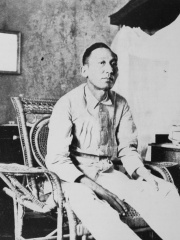
10. Apolinario Mabini (1864 - 1903)
With an HPI of 52.55, Apolinario Mabini is the 10th most famous Filipino Politician. His biography has been translated into 35 different languages.
Apolinario Mabini y Maranan (Tagalog: [apolɪˈnaɾ.jo maˈbinɪ]; July 23, 1864 – May 13, 1903) was a Filipino revolutionary leader, educator, lawyer, and statesman who served first as a legal and constitutional adviser to the Revolutionary Government, and then as the first Prime Minister of the Philippines upon the establishment of the First Philippine Republic. He is regarded as the "utak ng himagsikan" or "brain of the revolution" and is also considered as a national hero in the Philippines. Mabini's work and thoughts on the government shaped the Philippines' fight for independence over the next century. Two of his works, El Verdadero Decálogo (The True Decalogue, June 24, 1898) and Programa Constitucional de la República Filipina (The Constitutional Program of the Philippine Republic, 1898), became instrumental in the drafting of what would eventually be known as the Malolos Constitution. Mabini performed all his revolutionary and governmental activities despite having lost the use of both his legs to polio shortly before the Philippine Revolution of 1896. Mabini's role in Philippine history saw him confronting first Spanish colonial rule in the opening days of the Philippine Revolution, and then American colonial rule in the days of the Philippine–American War. The latter saw Mabini captured and exiled to Guam by American colonial authorities, allowed to return only two months before his eventual death in May 1903.
Pantheon has 45 people classified as politicians born between 1491 and 1978. Of these 45, 14 (31.11%) of them are still alive today. The most famous living politicians include Rodrigo Duterte, Gloria Macapagal Arroyo, and Joseph Estrada. The most famous deceased politicians include Ferdinand Marcos, Emilio Aguinaldo, and Lapu-Lapu. As of April 2022, 10 new politicians have been added to Pantheon including Macario Sakay, Leopoldo Serantes, and Pedro Paterno.
Living Politicians
Go to all Rankings
Rodrigo Duterte
1945 - Present
HPI: 78.54
Gloria Macapagal Arroyo
1947 - Present
HPI: 54.53
Joseph Estrada
1937 - Present
HPI: 50.19
Nur Misuari
1939 - Present
HPI: 41.66
Bongbong Marcos
1957 - Present
HPI: 39.97
Jejomar Binay
1942 - Present
HPI: 39.86
Leni Robredo
1965 - Present
HPI: 38.19
Juan Ponce Enrile
1924 - Present
HPI: 37.28
Noli de Castro
1949 - Present
HPI: 36.51
Manny Villar
1949 - Present
HPI: 33.29
Walden Bello
1945 - Present
HPI: 33.24
Leila de Lima
1959 - Present
HPI: 29.13

Deceased Politicians
Go to all Rankings
Ferdinand Marcos
1917 - 1989
HPI: 63.73
Emilio Aguinaldo
1869 - 1964
HPI: 62.40
Lapu-Lapu
1491 - 1542
HPI: 62.30
Corazon Aquino
1933 - 2009
HPI: 61.84
Benigno Aquino Jr.
1932 - 1983
HPI: 55.77
Manuel L. Quezon
1878 - 1944
HPI: 55.67
Jose P. Laurel
1891 - 1959
HPI: 53.66
Apolinario Mabini
1864 - 1903
HPI: 52.55
Elpidio Quirino
1890 - 1956
HPI: 51.95
Florencio Campomanes
1927 - 2010
HPI: 51.49
Manuel Roxas
1892 - 1948
HPI: 51.24
Benigno Aquino III
1960 - 2021
HPI: 50.86

Newly Added Politicians (2022)
Go to all Rankings
Macario Sakay
1878 - 1907
HPI: 45.89
Leopoldo Serantes
1962 - 2021
HPI: 45.49
Pedro Paterno
1857 - 1911
HPI: 45.37
Bongbong Marcos
1957 - Present
HPI: 39.97
Arturo Tolentino
1910 - 2004
HPI: 34.54
Manny Villar
1949 - Present
HPI: 33.29
Walden Bello
1945 - Present
HPI: 33.24
Leila de Lima
1959 - Present
HPI: 29.13
Sara Duterte
1978 - Present
HPI: 27.97
Loren Legarda
1960 - Present
HPI: 26.39

Which Politicians were alive at the same time? This visualization shows the lifespans of the 25 most globally memorable Politicians since 1700.

